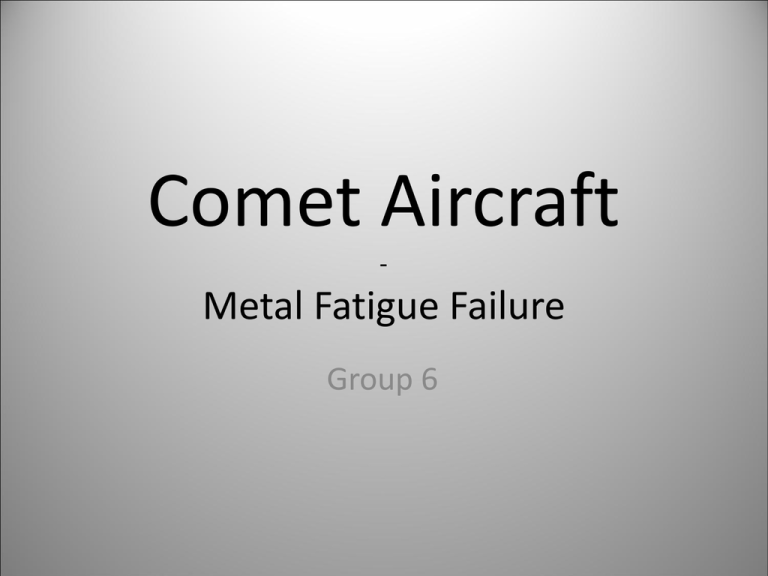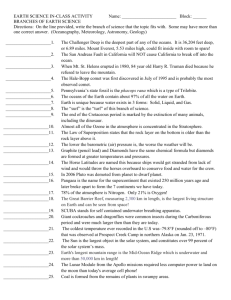group 6 presentation.ppt
advertisement

Comet Aircraft - Metal Fatigue Failure Group 6 • The de Havilland Comet was the world's first commercial jet airliner to reach Production designed by de Havilland • The Comet was designed after the second world war, in the mid 1940’s using the Advancements in aviation • The Comet prototype made its first test flight on the 27th July 1949, and lasted 31 minutes •The first production aircraft (G-ALYP) flew in January 1951. On 22 January 1952, G-ALYS was the first Comet to receive a certificate of airworthiness. • On 2 May, G-ALYP took off on the world's first all-jet flight with fare-paying passengers . •50% faster, with a 490 MPH cruising speed. • Two pairs of de Havilland Ghost 50 Mk1 turbojet engines were buried in the wings close to the fuselage •Ghost engine; • smooth • relatively simple • fuel-efficient •low maintenance costs •30,000ft enabled operations above weather rough. •Comet had 44 seats or used an even roomier arrangement of 36 seats. •30,000 passengers were carried during the first year of service and over 50 Comets were ordered. •Innovative Design Elements; •low-drag •a swept leading edge •integrated wing fuel tanks •four-wheel bogie main undercarriage •The Comet was also the first pressurised jet-propelled commercial aircraft. •For emergencies, life rafts were stored in the wings near the engines and a life vest was stowed under each seat bottom. •The Comet's thin metal skin which saved weight and reduced the risk of fatigue cracks spreading from the rivets. •When it went into service with BOAC on 2 May 1952, the Comet was the most exhaustively tested airliner in history. •This was equivalent to about 40,000 hours of airline service •The windows were tested under a pressure of 12 psi, 4.75 psi above the normal service ceiling of 36,000 ft (10,973 m). •One window frame survived a massive 100 psi, about 1,250% over the maximum pressure it would encounter in service. •Two Accidents •26 October 1952, a flight failed to become airborne and ran into rough ground at the end of the runway. •March 1952, also failed to become airborne on takeoff the aircraft plunged into a dry drainage canal. •Both of these accidents were originally attributed to pilot error. •10 January 1954, Comet G-ALYP BOAC Flight 781, disintegrated in flight and crashed into the Mediterranean with the loss of all a board. •There was no obvious reason for the crash, and the fleet was grounded. •The Royal Navy conducted recovery operations •12th January The first wreckage was discovered •Search continued until August •70 % of the main structure •80 % of the power section •50 % of the equipment •The committee concluded fire was the most likely cause of the problem •Number of changes were made to the aircraft to protect the engines and wings from damage. •The position of the mounted engines in the wings, increased the structural weight and general complexity, including armour for the engine cells. •This arrangement also carried higher risk of catastrophic wing failure in case of an engine fire. On 4 April, to the Minister of Transport, "Although no definite reason for the accident has been established, modifications are being embodied to cover every possibility that imagination has suggested as a likely cause of the disaster. When these modifications are completed and have been satisfactorily flight tested, the Board sees no reason why passenger services should not be resumed." Comet flights resumed on 23 March 1954. •8 April 1954, Comet G-ALYY ("Yoke Yoke"), crashed in the waters near Naples. •The fleet was immediately grounded once again •Royal Aircraft Establishment carried out an investigation •An identical airframe, was repeatedly re-pressurisation and over-pressurisation. The frame failed due to metal fatigue near the front port-side escape hatch. •Stress around the window corners was found to be much higher than expected, nearly over 40,000 psi. •Stresses on the skin were generally more than previously expected or tested. This was due to stress concentration, a consequence of the window's square shape. •The windows had been engineered to be glued and riveted, but had been punch riveted only. Causing a difference form the design phase to production. •The principal investigator concluded, "In the light of known properties of the aluminium alloy D.T.D. 546 or 746 of which the skin was made and in accordance with the advice I received from my Assessors, I accept the conclusion of RAE that this is a sufficient explanation of the failure of the cabin skin by fatigue after a small number, namely, 3,060 cycles of pressurisation." •Before the Elba accident, G-ALYP had made 1,290 pressurised flights and at the time of the Naples accident, and G-ALYY had made 900 pressurised flights. •The Comet 4 series subsequently enjoyed a long and productive career of over 30 years, although sales never fully recovered. The Hawker Siddeley Nimrod, the military derivative of the Comet airliner, is still in service. The original decades-old airframes are being rebuilt with new wings and engines to produce the Nimrod MRA 4, expected to serve with Britain's Royal Air Force until the 2020s, almost 70 years after the Comet's first flight.





